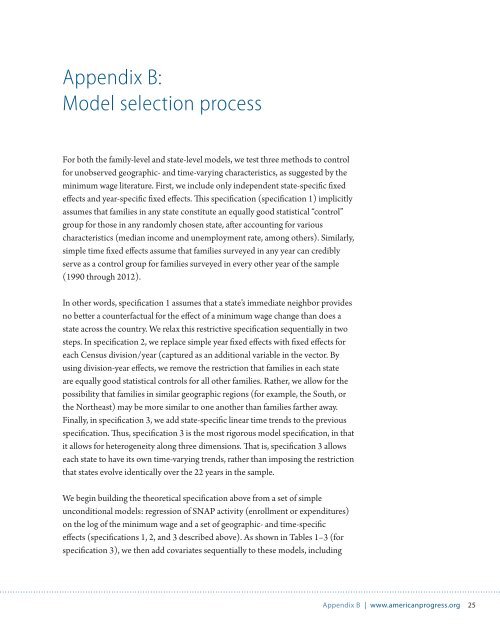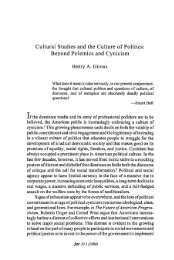effects-of-minimum-wages-on-snap
effects-of-minimum-wages-on-snap
effects-of-minimum-wages-on-snap
You also want an ePaper? Increase the reach of your titles
YUMPU automatically turns print PDFs into web optimized ePapers that Google loves.
Appendix B:<br />
Model selecti<strong>on</strong> process<br />
For both the family-level and state-level models, we test three methods to c<strong>on</strong>trol<br />
for unobserved geographic- and time-varying characteristics, as suggested by the<br />
<str<strong>on</strong>g>minimum</str<strong>on</strong>g> wage literature. First, we include <strong>on</strong>ly independent state-specific fixed<br />
<str<strong>on</strong>g>effects</str<strong>on</strong>g> and year-specific fixed <str<strong>on</strong>g>effects</str<strong>on</strong>g>. This specificati<strong>on</strong> (specificati<strong>on</strong> 1) implicitly<br />
assumes that families in any state c<strong>on</strong>stitute an equally good statistical “c<strong>on</strong>trol”<br />
group for those in any randomly chosen state, after accounting for various<br />
characteristics (median income and unemployment rate, am<strong>on</strong>g others). Similarly,<br />
simple time fixed <str<strong>on</strong>g>effects</str<strong>on</strong>g> assume that families surveyed in any year can credibly<br />
serve as a c<strong>on</strong>trol group for families surveyed in every other year <str<strong>on</strong>g>of</str<strong>on</strong>g> the sample<br />
(1990 through 2012).<br />
In other words, specificati<strong>on</strong> 1 assumes that a state’s immediate neighbor provides<br />
no better a counterfactual for the effect <str<strong>on</strong>g>of</str<strong>on</strong>g> a <str<strong>on</strong>g>minimum</str<strong>on</strong>g> wage change than does a<br />
state across the country. We relax this restrictive specificati<strong>on</strong> sequentially in two<br />
steps. In specificati<strong>on</strong> 2, we replace simple year fixed <str<strong>on</strong>g>effects</str<strong>on</strong>g> with fixed <str<strong>on</strong>g>effects</str<strong>on</strong>g> for<br />
each Census divisi<strong>on</strong>/year (captured as an additi<strong>on</strong>al variable in the vector. By<br />
using divisi<strong>on</strong>-year <str<strong>on</strong>g>effects</str<strong>on</strong>g>, we remove the restricti<strong>on</strong> that families in each state<br />
are equally good statistical c<strong>on</strong>trols for all other families. Rather, we allow for the<br />
possibility that families in similar geographic regi<strong>on</strong>s (for example, the South, or<br />
the Northeast) may be more similar to <strong>on</strong>e another than families farther away.<br />
Finally, in specificati<strong>on</strong> 3, we add state-specific linear time trends to the previous<br />
specificati<strong>on</strong>. Thus, specificati<strong>on</strong> 3 is the most rigorous model specificati<strong>on</strong>, in that<br />
it allows for heterogeneity al<strong>on</strong>g three dimensi<strong>on</strong>s. That is, specificati<strong>on</strong> 3 allows<br />
each state to have its own time-varying trends, rather than imposing the restricti<strong>on</strong><br />
that states evolve identically over the 22 years in the sample.<br />
We begin building the theoretical specificati<strong>on</strong> above from a set <str<strong>on</strong>g>of</str<strong>on</strong>g> simple<br />
unc<strong>on</strong>diti<strong>on</strong>al models: regressi<strong>on</strong> <str<strong>on</strong>g>of</str<strong>on</strong>g> SNAP activity (enrollment or expenditures)<br />
<strong>on</strong> the log <str<strong>on</strong>g>of</str<strong>on</strong>g> the <str<strong>on</strong>g>minimum</str<strong>on</strong>g> wage and a set <str<strong>on</strong>g>of</str<strong>on</strong>g> geographic- and time-specific<br />
<str<strong>on</strong>g>effects</str<strong>on</strong>g> (specificati<strong>on</strong>s 1, 2, and 3 described above). As shown in Tables 1–3 (for<br />
specificati<strong>on</strong> 3), we then add covariates sequentially to these models, including<br />
Appendix B | www.americanprogress.org 25




